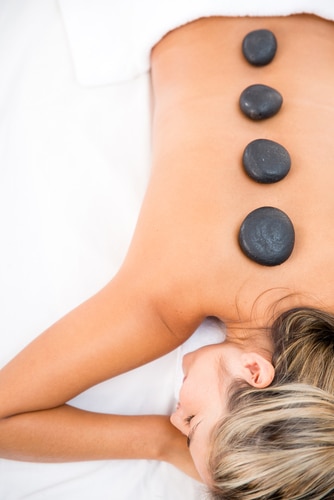
Massage versus Exercise for Post-Exercise Muscle Soreness
In a study published in the Journal of Strength and Conditioning Research, researchers looked at the effect of massage versus exercise for relieving delayed-onset muscle soreness, also known as DOMS. They induced muscle soreness in a group of 20 healthy females by asking them to do eccentric exercises involving their trapezius muscles. Eccentric exercises, where the muscles are lengthened against resistance, are the most damaging to muscle fibers. They’re more likely to cause muscle soreness than concentric movements where the muscles are shortened against resistance.
As expected in this study, the participants experienced soreness after their eccentric workout. Massage or exercise – which was better for easing the soreness? They both were. Researchers found massage and active exercise using resistance bands were equally effective for reducing muscle soreness in the participants. There was only one downside. The relief was temporary, lasting only about an hour for both modalities. Still, this study suggests you’ll get just as much benefit actively exercising your muscles when they’re sore as you will passively massaging them.
Why Moving Your Muscles Helps DOMS
No one knows EXACTLY what causes DOMS. One theory is exposing your muscles to higher tension than they’re accustomed to causes structural damage that repairs itself within a few days to a week. Another theory is overloading muscle tissue increases the temperature of the muscle. This rise in temperature causes structural damage that leads to pain and soreness. Other sources believe DOMS is related to an accumulation of metabolic waste products. If this is the case, moving muscles when they’re sore should help mobilize and eliminate some of the waste products.
Why do eccentric movements where you lengthen the muscle cause more soreness? When you exercise a muscle eccentrically by lengthening it as you “brake” it, you activate fewer muscle fibers than you do with a flexion or concentric contraction where you contract the muscle against resistance. With an eccentric movement, you’re placing equivalent force over a smaller number of muscle fibers. This causes more tearing and stretching of muscle fibers – and more pain. Examples of eccentric contractions are lowering a barbell or running downhill. In both cases, you’re lengthening muscles in a controlled manner.
Other Treatments for Delay-Onset Muscle Soreness
DOMS has been the focus of considerable research in hopes of finding treatments that help the discomfort. Some that have been tested and not shown to work include hyperbaric oxygen therapy, low-intensity laser treatment, pulsed electrical current, and acupuncture. Modalities that show promise based on small studies include whole body vibration therapy, ice-water immersion, low-level heat wrap therapy, and moist heat. One study showed supplementing with branched-chain amino acids reduced delayed-onset muscle soreness in participants doing squats.
For most people, DOMS is self-limited, regardless of how it’s treated. Most people don’t need expensive therapies that may or may not work. Ice packs work reasonably well for easing the discomfort. Some people use non-steroidal anti-inflammatory medications but it’s not clear how effective they are for DOMS. They also have side effects.
Should You Keep Exercising?
There’s no evidence that exercising with DOMS delays recovery. In fact, based on the study above, moving sore muscles offers temporary relief from the discomfort and is as effective as massage for short-term relief. On the other hand, it’s a good idea to reduce the intensity of your workout. Research shows muscles that are sore due to DOMS lose up to 30% of their strength. Trying to maintain the same workout intensity with sore, overworked muscles could alter your form and increase your risk for injury. That doesn’t mean you can’t exercise at a lower intensity.
Stretches and resistance exercises using bands or light weights with higher repetition will get the blood flowing through your muscles and temporarily reduce the discomfort. Yoga is another form of exercise that may help. A study published in the Journal of Strength and Conditioning Research showed yoga, even a single session, helps to ease post-exercise soreness due to DOMS.
Although DOMS is more common in people who are untrained, even trained athletes and bodybuilders can get it when they increase the intensity or duration of their workout or work untrained muscles. Once you’ve developed one bout of post-workout soreness involving a muscle group, that muscle group develops some degree of resistance to further soreness or damage that lasts for weeks to months. You may experience soreness if you change the intensity of your workout but it won’t be as uncomfortable or last as long as the initial bout.
The Bottom Line?
You may be tempted to take it easy when your muscles are sore after a tough workout but a little movement will make them feel better. Stretching exercises, yoga and resistance exercises using light weights or resistance bands all work well. Listen carefully to your body. If a movement causes pain, it’s a sign you need to lower the intensity or switch to stretching exercises. The good news is the soreness will go away on its own in about a week.
References:
Journal of Strength and Conditioning Research 27(12): 3352-3359, 2013.
Medscape Reference. “Postexercise Muscle Soreness”
ACSM.org. “Delayed Onset Muscle Soreness”
More Magazine. “Muscles Sore, They Shouldn’t Be”
J Strength Cond Res. 2004 Nov;18(4):723-9.
Related Articles By Cathe:
Delayed Onset Muscle Soreness – Causes, Effects and Prevention
How to Work Out When You’re Sore & Why You Should
Does Foam Rolling Reduce Delayed Onset Muscle Soreness?
Do You Really Need More Exercise Recovery Time as You Age?

